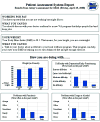Using patient-facing kiosks to support quality improvement at mental health clinics
- PMID: 23407006
- PMCID: PMC3654521
- DOI: 10.1097/MLR.0b013e31827da859
Using patient-facing kiosks to support quality improvement at mental health clinics
Abstract
Objectives: Evidence-based services improve outcomes in schizophrenia, but most patients at mental health clinics do not receive such services. This gap in care has been perpetuated by a lack of routinely collected data on patients' clinical status and the treatments they receive. However, routine data collection can be completed by patients themselves, especially when aided by health information technology. It is not known whether these data can be used to improve care quality.
Methods: In a controlled trial, 8 medical centers of the Veterans Health Administration were assigned to implementation or usual care. A total of 571 patients with schizophrenia were overweight and had not used evidence-based weight services. The implementation strategy included data from patient-facing kiosks, continuous data feedback, clinical champions, education, social marketing, and evidence-based quality improvement teams. Mixed methods evaluated the impact of the kiosks on utilization of and retention in weight services.
Results: Compared with usual care, implementation resulted in individuals being more likely to use weight services, availing services >5 weeks sooner, and continuing to use the services 3 times more. When compared with the year before implementation, patients at implementation sites saw a 3-fold increase in treatment visits. Usual care resulted in no change.
Conclusions: Mental health clinics have been slow to adopt health information technology. This study is among the first to implement and evaluate automated collection of data from patients at these clinics. Patient-facing kiosks are feasible in routine care and provide data that can be used to substantially improve the quality of care.
Figures
Similar articles
-
Implementation outcomes of evidence-based quality improvement for depression in VA community based outpatient clinics.Implement Sci. 2012 Apr 11;7:30. doi: 10.1186/1748-5908-7-30. Implement Sci. 2012. PMID: 22494428 Free PMC article. Clinical Trial.
-
Implementation of evidence-based employment services in specialty mental health.Health Serv Res. 2013 Dec;48(6 Pt 2):2224-44. doi: 10.1111/1475-6773.12115. Epub 2013 Oct 21. Health Serv Res. 2013. PMID: 24138608 Free PMC article.
-
Change in Patient Outcomes After Augmenting a Low-level Implementation Strategy in Community Practices That Are Slow to Adopt a Collaborative Chronic Care Model: A Cluster Randomized Implementation Trial.Med Care. 2019 Jul;57(7):503-511. doi: 10.1097/MLR.0000000000001138. Med Care. 2019. PMID: 31135692 Free PMC article. Clinical Trial.
-
Systematic reviews of the effectiveness of day care for people with severe mental disorders: (1) acute day hospital versus admission; (2) vocational rehabilitation; (3) day hospital versus outpatient care.Health Technol Assess. 2001;5(21):1-75. doi: 10.3310/hta5210. Health Technol Assess. 2001. PMID: 11532238 Review.
-
Using implementation mapping for the adoption and implementation of Target:BP in community health centers.Front Public Health. 2022 Nov 24;10:928148. doi: 10.3389/fpubh.2022.928148. eCollection 2022. Front Public Health. 2022. PMID: 36504969 Free PMC article. Review.
Cited by
-
Practice-based research networks add value to evidence-based quality improvement.Healthc (Amst). 2018 Jun;6(2):128-134. doi: 10.1016/j.hjdsi.2017.06.008. Epub 2017 Jul 13. Healthc (Amst). 2018. PMID: 28711505 Free PMC article.
-
Preferences for family involvement among veterans in treatment for schizophrenia.Psychiatr Rehabil J. 2019 Sep;42(3):210-219. doi: 10.1037/prj0000352. Epub 2019 Mar 28. Psychiatr Rehabil J. 2019. PMID: 30920257 Free PMC article.
-
Evaluation of Multimedia Medication Reconciliation Software: A Randomized Controlled, Single-Blind Trial to Measure Diagnostic Accuracy for Discrepancy Detection.Appl Clin Inform. 2018 Apr;9(2):285-301. doi: 10.1055/s-0038-1645889. Epub 2018 May 2. Appl Clin Inform. 2018. PMID: 29719884 Free PMC article. Clinical Trial.
-
Computerized Conjoint Analysis of the Weight Treatment Preferences of Individuals With Schizophrenia.Psychiatr Serv. 2021 Mar 1;72(3):288-294. doi: 10.1176/appi.ps.202000068. Epub 2021 Jan 12. Psychiatr Serv. 2021. PMID: 33430650 Free PMC article.
-
Evidence-Based Quality Improvement: a Scoping Review of the Literature.J Gen Intern Med. 2022 Dec;37(16):4257-4267. doi: 10.1007/s11606-022-07602-5. J Gen Intern Med. 2022. PMID: 36175760 Free PMC article.
References
-
- Druss BG, Rohrbaugh RM, Levinson CM, et al. Integrated medical care for patients with serious psychiatric illness: a randomized trial. Arch Gen Psychiatry. 2001 Sep;58(9):861–868. - PubMed
-
- Perala J, Suvisaari J, Saarni SI, et al. Lifetime prevalence of psychotic and bipolar I disorders in a general population. Arch Gen Psychiatry. 2007 Jan;64(1):19–28. - PubMed
-
- Lehman AF. Quality of care in mental health: the case of schizophrenia. Health Affairs. 1999;18(5):52–65. - PubMed
-
- West JC, Wilk JE, Olfson M, et al. Psychiatric services. 3. Vol. 56. Washington, D.C.: 2005. Patterns and quality of treatment for patients with schizophrenia in routine psychiatric practice; pp. 283–291. - PubMed
Publication types
MeSH terms
Grants and funding
LinkOut - more resources
Full Text Sources
Other Literature Sources
Medical
Miscellaneous



